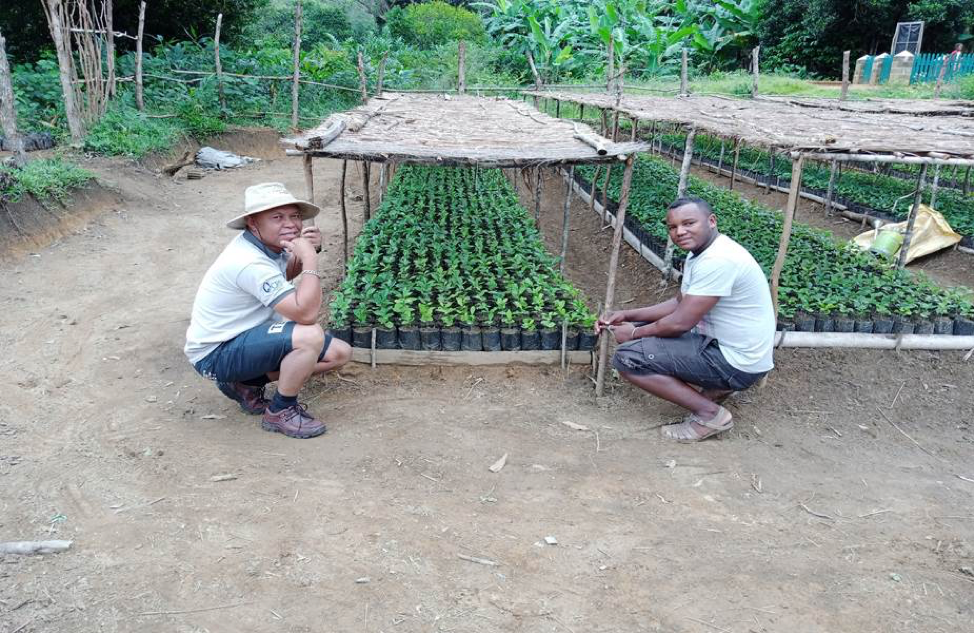
While we often hear about lemurs, vanilla and other spices when talking about Madagascar, we don’t always think about coffee. However, Madagascar has been a long-time producer of coffee – both arabica and robusta which is mainly bought, sold and consumed in local markets. You will find coffee in almost any local market, and usually a strong dose is mixed with just enough sugar and condensed milk to soften the bite.
Additionally, Madagascar was identified with some of the most unique, and at-risk varieties in the world. Did you know that a naturally caffeine free variety can be found in the forests of Madagascar?
During the colonial period (1897-1958), the French divided up the country into several agricultural zones with coffee being prioritized in the east and southeast. Robusta trees are thus mainly found along the eastern coast; an area where CRS has been working for years to support farmers and reduce the impacts of severe deforestation due to charcoal production, slash and burn agriculture and some mining. Many coffee trees are quite old, of lesser quality, and most farmers have not been trained on agronomy basics – mulching, pruning, etc. – when planting new trees. CRS has worked with the government research facility, FOFIFA (Centre National de la Recherche Appliquée au Développement Rural / Foibem-pirenena momba ny Fikarohana ampiharina amin’ny Fampandrosoana ny eny Ambanivohitra) on a number of fronts in the effort to improve the coffee sector in the country, including work on a new high quality biclonal coffee variety.
CRS and FOFIFA set up new mother nurseries and subsequent smaller nurseries which have become incredibly popular. Thus far, 20 nursery managers have been trained as lead farmers who then provide the practical training to their neighbor farmers. To date, the nursery sites have been able to produce 81,179 coffee plants which can cover over 17 ha. of coffee plantations.
Now, through the Securing and Protecting Investments & Capacities for Environmental Sustainability (SPICES) program, coffee is an integral species going into integrated agroforestry systems that include cash crops (coffee, cinnamon, vanilla, etc.), fruits and endemic trees – to both restore land and improve livelihoods. Coffee is an important asset for the farmers, as its harvested Sept-Oct right when families need to pay school fees for their children. This also falls during the lean season, enabling farmers to fall back on coffee is critical to making ends meet during what is often a difficult period.
Agroforestry for people, profit and planet: what does an ideal system look like?
Coffee is but one crop in the agroforestry system being considered and promoted by the SPICEs program. But what does an agroforestry system actually look like? How many layers are in a system? How can we design one to deliver the highest level of economic return for the farmer while also promoting sustainability, reforestation, and climate mitigation?
With so many interrelated variables affecting AFS, innumerable designs for any given geographic location are possible. In Madagascar, the SPICES project has been working with the Centre ValBio. This local conservation center works to protect Madagascar’s unique and biologically diverse ecosystems through conversation science and projects that directly benefit the local people. Together with CRS, Valbio is helping to design appropriate agroforestry systems for the SPICES program.
The project’s agroforestry designs feature four or five key strata, or layers, each of which serves a specific purpose. The below schema represents one such design (Musaceae are banana trees).

While coffee is one option for an income generating crop, many options exist, and farmers often combine multiple crops. In the example below, vanilla and cinnamon have been selected as cash crops, while cloves and pineapple provide further income.

The scenario above presents one possible ideal objective, but is also representative of what some farmers are already striving towards in an attempt to diversify their incomes. Currently, as the program is still young, SPICES is installing nurseries for producing seedlings for reforestation, including both native species and those of the revenue crops. As the project scales up, it will be exciting to see which agroforestry designs are most adopted by farmers.
For further questions, please reach out to the CRS Chief of Party, Jim Hazen, [email protected]





